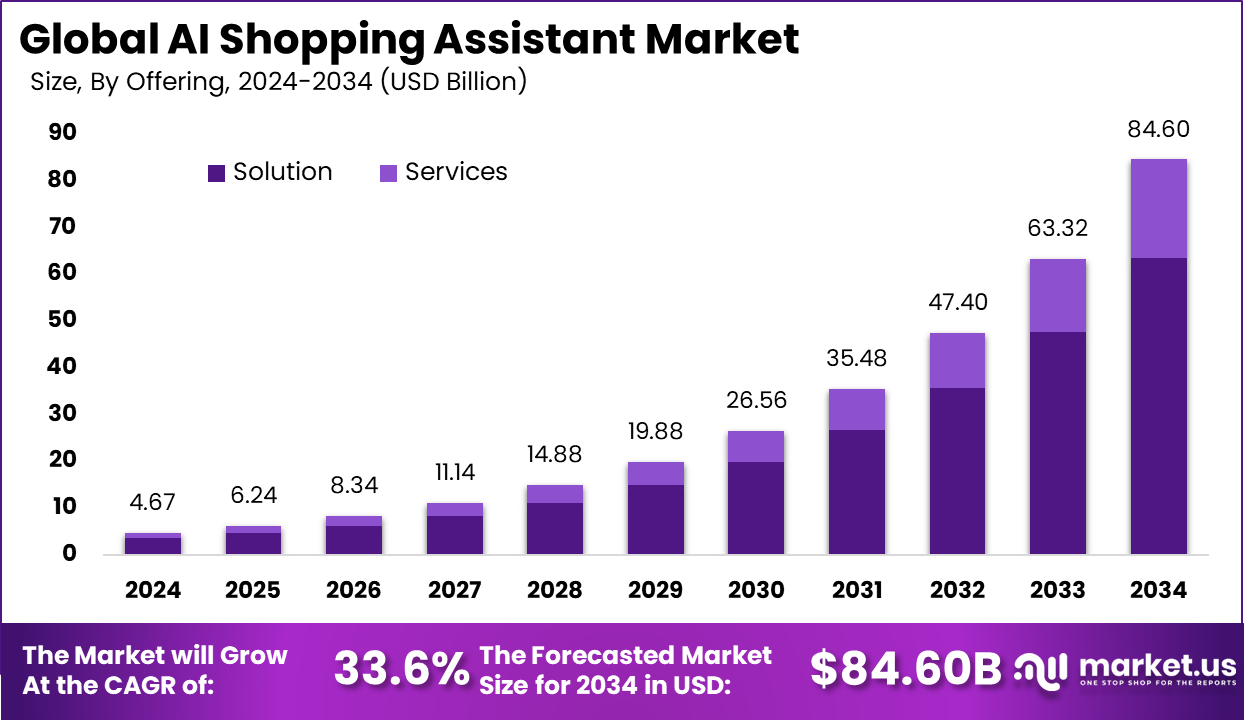Table of Contents
Introduction
The Global AI Shopping Assistant Market, valued at USD 4.67 billion in 2024, is expanding rapidly as consumers and retailers adopt intelligent automation for personalized shopping. With a strong 33.6% CAGR, the market is projected to reach USD 84.60 billion by 2034, driven by AI-powered recommendations, voice-enabled commerce, and smart retail ecosystems. North America leads with a 39.4% share (USD 1.83 billion), reflecting high adoption of digital shopping technologies.

How Growth Is Impacting the Economy
The surge in AI shopping assistants is reshaping economic productivity through automation, enhanced consumer engagement, and streamlined retail operations. Increased use of generative AI reduces manual customer-support costs, boosts conversion rates, and strengthens digital commerce infrastructure. This growth stimulates technological investments, accelerates cloud-computing demand, and expands the digital workforce.
As retailers integrate AI into omnichannel environments, the economy benefits from increased retail efficiency, reduced operational bottlenecks, and improved supply-demand balance. The market’s projected rise to USD 84.60 billion by 2034 signals the expansion of economic value creation as more industries adopt AI-driven shopping experiences. Additionally, the technology fuels innovation in payments, logistics, and last-mile delivery, strengthening the broader digital economy.
➤ Smarter strategy starts here! Get the sample – https://market.us/report/ai-shopping-assistant-market/free-sample/
Impact on Global Businesses
Rising AI infrastructure costs, compute requirements, and data-handling expenses are pushing businesses toward hybrid-cloud and on-device AI solutions. Supply chains are shifting toward automated demand forecasting, inventory optimization, and digital procurement to reduce friction. Sector impacts are diverse: retail benefits from personalized experiences, e-commerce gains from higher engagement, fashion sees faster trend prediction, and FMCG enjoys optimized replenishment patterns.
Strategies for Businesses
Businesses should adopt scalable AI platforms, prioritize data governance, and integrate AI assistants across websites, apps, and in-store systems. Investing in multilingual support, predictive analytics, and omnichannel automation can enhance customer journeys. Strong partnerships with AI solution providers, workforce AI-skill development, and continuous testing of AI recommendations will ensure sustained competitiveness.
Key Takeaways
- Market value to reach USD 84.60 billion by 2034.
- Strong 33.6% CAGR highlights rapid AI retail adoption.
- North America leads with 39.4% share and USD 1.83 billion in revenue.
- AI shopping assistants are improving global retail efficiency and personalization.
- Rising demand for predictive analytics and voice-based commerce.
➤ Unlock growth secrets! Buy the full report – https://market.us/purchase-report/?report_id=166997
Analyst Viewpoint
Current market performance reflects growing integration of generative AI, natural language processing, and personalization engines across digital retail. Present adoption is fueled by convenience, automation, and cost reduction. Future growth remains highly positive as enterprises scale AI assistants across omnichannel platforms, integrate autonomous commerce, and expand into emerging markets. Continuous innovation in multimodal AI, behavioral analytics, and real-time recommendations will accelerate long-term adoption and strengthen market maturity.
Use Cases & Growth Factors
| Use Case | Description | Growth Factors |
|---|---|---|
| Personalized Shopping | Tailored product suggestions across channels | Rise in data-driven retail & recommendation engines |
| Virtual Try-Ons | AR/AI for apparel & cosmetics | Growth in immersive commerce |
| Customer Support Automation | Chat-based query handling & order tracking | Demand for 24/7 digital assistance |
| Price Optimization | Dynamic pricing & promotions | AI-based demand forecasting |
Regional Analysis
North America maintains dominance with a 39.4% share due to high digital retail penetration, a mature e-commerce infrastructure, and rapid adoption of conversational AI. Europe follows with strong regulatory-driven AI usage and growing retail automation. Asia-Pacific is the fastest-growing region, propelled by mobile-first shoppers, expanding online marketplaces, and AI adoption by SME retailers. Latin America and the Middle East are gradually strengthening adoption as digital payments and e-commerce ecosystems expand.
➤ Want more market wisdom? Browse reports –
- Laser Drones Market
- Reconnaissance Drone Market
- Music Market
- Social Employee Recognition System Market
Business Opportunities
Significant opportunities arise from multimodal recommendation engines, AI-powered virtual stylists, voice-commerce platforms, and autonomous shopping workflows. Retailers can unlock new revenue streams by integrating AI assistants into loyalty programs, subscription models, and personalized promotions. Opportunities also grow in AI data training, edge-AI retail devices, and hyper-local commerce automation. Emerging markets present strong potential due to rising smartphone penetration and e-commerce acceleration.
Key Segmentation
The market can be segmented by deployment model (cloud-based, on-premise), technology (NLP, generative AI, speech recognition, computer vision), application (product discovery, virtual assistance, customer support, pricing and promotions), and end-user (e-commerce, retail stores, D2C brands, marketplaces). Each segment shows strong adoption momentum as retailers optimize user experience, reduce decision time, and enhance cross-channel personalization. Future segmentation growth is expected in autonomous checkout and immersive commerce solutions.
Key Player Analysis
Key participants focus on enhancing multimodal AI capabilities, building scalable recommendation systems, and strengthening data-privacy frameworks. Innovation centers on creating more human-like conversational flows, improving contextual understanding, and enabling real-time product matching. Competitors invest heavily in cloud integration, edge-device optimization, and API ecosystems that support enterprise-scale AI rollouts. R&D efforts target lowering inference latency, expanding multilingual support, and improving personalization accuracy across global markets.
- Alibaba Group Holding Limited
- Shopify Inc.
- Salesforce, Inc.
- eBay Inc.
- Google LLC
- Amazon.com, Inc
- Meta Platforms, Inc.
- Microsoft Corporation
- Adobe Inc.
- IBM Corporation
- Others
Recent Developments
- Launch of new multimodal AI shopping engines with enhanced image-to-text capabilities.
- Rollout of real-time voice-commerce integrations for mobile retailers.
- Expansion of cloud-based retail AI APIs supporting global e-commerce platforms.
- Introduction of AI-based virtual stylist tools for the apparel and beauty sectors.
- Partnerships formed to integrate AI assistants into POS and checkout systems.
Conclusion
The AI shopping assistant market is entering a transformative phase, driven by rising demand for personalized and automated retail experiences. With strong growth forecasts and expanding use cases, businesses adopting AI-driven commerce stand to gain a significant competitive advantage while shaping the future of global retail.
Discuss your needs with our analyst
Please share your requirements with more details so our analyst can check if they can solve your problem(s)



